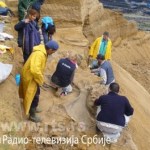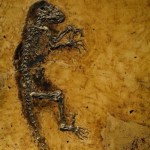paleontology
If you can handle some more hype about human evolution, here's a snippet from the (more or less) recent BBC documentary "The Ape That Took Over the World." It is about the controversial placement of Kenyanthropus in hominid evolution;
I do not have time to do a full write-up here (especially since I have not as yet seen the show in full), but the evolutionary placement of Kenyanthropus is more controversial than this clip admits. Kenyanthropus appears to be a hominin, but whether it represents a new genus, an already-known form of Australopithecus, or something else is still being debated…
Fossil teeth can be tricky things. In 1922 paleontologist H.F. Osborn believed that he had found the first evidence of an extinct fossil ape from North America on the basis of a worn molar from Nebraska, but it later turned out to be the tooth of a prehistoric peccary. Four years later, by contrast, Davidson Black named a new species of ancient human on the basis of a handful of teeth recovered from Dragon Bone Hill in China. These turned out to belong to Homo erectus. Both paleontologists made bold steps on the basis of sparingly little evidence, but with entirely different outcomes.
Last…
They Might Be Giants is soon going to release a new educational album called Here Comes Science, and one of the songs on it is about paleontology! It's hard to make out most of the lyrics from the video below, but it's called "I am a Paleontologist."
The skull of a spotted hyena (Crocuta crocuta), photographed at the AMNH's "Extreme Mammals" exhibit.
[Author's note: This post gets a little bit graphic, so those who are made squeamish by taphonomy might want to skip this one.]
There was something funny about the assemblage of Homo erectus fossils found at Dragon Bone Hill in Zhoukoudian, China. There were plenty of teeth and skulls but scarcely any post-cranial remains. Where were the bodies?
The majority of Homo erectus fossils from Zhoukoudian were discovered and studied by an international team of scientists during the 1920's and…
Paleo-blogger Zach has revitalized the long-dormant Boneyard carnival over at When Pigs Fly Returns. He has collected a nice assortment of links, but if you want to submit some more, Zach's the guy to talk to. I am sorry that I no longer have the time to run the Boneyard myself, but I am glad that others are going to keep it going. Thanks, Zach!
The exceptionally preserved skeleton of Darwinius, known popularly as "Ida." From PLoS One.
Even though it has been about a month since Darwinius (or "Ida", if you like) hit the public scene there is still plenty to talk about. From uncertain evolutionary relationships to the interaction between scientists and the media, this controversy has given us plenty to discuss. One of the most worrying aspects of this entire ordeal, however, has been the prospect that media companies influenced the scientific study of Ida.
As Earle Holland wrote on the Ohio State University On Research... blog, the…
It's a difficult time for paleontologists. Young scientists struggle to find a place in an ever-dwindling pool of jobs and academic positions, and established scientists can sometimes have the rug pulled right out from under them. This latter misfortune befell the paleontologists at the University of Wyoming. Due to a $18.3 million cut to the Wyoming's budget the museum at the University of Wyoming will be closed and the two paleontologists who work there will be laid off (in addition to 43 other jobs cut at the school).
This is truly a shame. The museum is not only essential for research,…
A restoration of the skull of Thylacoleo. From The Ancient Life History of the Earth.
Without a doubt, the extinct marsupial predator Thylacoleo was one of the strangest carnivorous mammals ever to have evolved. This predator from ancient Australia did not have piercing canines but instead bit into prey with large, forward facing incisors, and it sheared flesh from its kills with huge, cleaver-like premolars. Even though it evolved from herbivorous ancestors, we now know that Thylacoleo was most certainly a carnivore.
The preferred diet of Thylacoleo has not always been so clear-cut,…
In case you haven't heard, the latest edition of the journal Evolution: Education and Outreach is almost entirely about transitional fossils. There's something for everyone, from synapsids to onychophorans, so make sure you check it out!
My only complaint, though, is that there is not a paper about early hominins or human evolution. Human evolution is often ignored or given short shrift when we talk about transitional fossils, yet the past several decades have seen an explosion in new types of extinct humans. I have no idea why such a paper does not appear in the collection (perhaps one was…
An almost complete and beautifully preserved fossil of the Southern Mammoth, Mammuthus meridionalis was discovered a couple of weeks ago by a team of archaeologists led by Miomir KoraÄ from the Archaeological Institute Belgrade and the Director of the Archaeological park Viminacium in Eastern Serbia.
The fossil, pretty much articulated and all in one place, was discovered at a depth of 27 meters (about 88.5 feet) in sand, which indicates that this area did not experience a serious earthquake for at least a million years or more since the animal died. It was identified as a female. She was…
Not so long ago it seemed that the "Lucy's Legacy" exhibit, which features the world's most famous fossil hominin, was coming to an end. The exhibition failed to bring in the crowds that were expected and there were doubts as to whether it would continue. According to a story about the exceptionally-talented paleo-artist Viktor Deak that appeared in this week's New York Times, however, it looks like Lucy is coming to Manhattan;
[Deak's] 78-foot-long mural showing six million years' worth of the proto-humans whose bony bits have been found in northeast Africa is coming to Manhattan in June as…
The face of Anoiapithecus. From Moya-Sola et al. (2009).
One of the most controversial aspects of the whole Darwinius kerfuffle has been the primate's proposed status as "the ancestor of us all." The fossil, named "Ida", has been popularly touted as the "missing link" connecting us to all other mammals, but how can we really know if Darwinius fits this role? The truth is that we can't, and it is nearly impossible to parse direct ancestor-descendant relationships among fossil vertebrates, especially when we're talking about a fossil that lived over 40 million years before the first…
The exceptionally preserved skeleton of Darwinius, known popularly as "Ida." From PLoS One.
Last month an international team of paleontologists lifted the veil on one of the most spectacular fossils ever discovered; a 47-million-year-old primate they named Darwinius masillae. It was a major event, but not everything went as planned. This fossil, popularly known as "Ida", immediately sparked a controversy about the relationship between science and the media, the ethics of buying fossils from private collectors, and what our distant primate ancestors were like.
Indeed, the media blitz…
I just watched the BBC's documentary on "Ida" (Darwinius masillae), "Uncovering Our Earliest Ancestor", and to be honest I was not very impressed. Rather than dissect the show second-by-second, though, I will only discuss some of the main points that occurred to me while watching it. Heaven knows I have spent plenty of time on Ida already...
While I surely appreciate the show's efforts (however fleeting) to describe the paleobiology of Ida, the show's real hook is the conclusion that Darwinius is one of our earliest primate ancestors. This is a tantalizing hypothesis, but is it true? The…
Last week also demonstrated another benefit of Open Access. Not just that everyone could re-use the images from the Ida paper without wondering "is this too much for Fair Use principles?" (yes, I have seen people re-post every single image from the paper into their articles/posts, plus lengthy excerpts of text), but people could do fun stuff to them as well, and even use it for commercial endeavors.
And I am not talking just about the Google logo last Wednesday!
First to make a creative reuse of an article image was Ed Yong in his brilliant and hilariously funny post Darwinius changes…
The "Hesperopithecus" tooth discovered by Harold Cook.
I could see it coming from a mile away. As soon as I heard all the hype surrounding "Ida", the exceptionally preserved specimen of Darwinius announced last week, I knew creationists would soon be citing our old friends "Archeoraptor", "Piltdown Man", and "Nebraska Man" as reasons not to trust evolutionary scientists. Each was a public embarrassment to scientists, that is true, but there is no reason to sweep these mistakes under the rug. Each can tell us something valuable about the way science works and how scientists interact with…
A paper published May 19 in PLoS ONE has the blogosphere in a frenzy over a 47 million-year-old primate fossil unearthed in Germany that might be the ancestor of all modern day humans, monkeys and apes. Scientists discovered the fossil—they're calling it Ida—in 1983, but only recently has it been restored. Ida was once a lemur-like animal and belongs to a newly classified genus and species, Darwinius masillae. The most intact primate fossil discovered to date, the find will have particular meaning to evolutionary biologists who have long searched for a "missing link," though ScienceBlogger…
I broke the news via my Twitter feed last night, but in case you missed it my op-ed "The dangerous link between science and hype" has been published in today's Times. I will give you one guess as to what it is about.
During the first Congressional hearing on the IPCC report on human-induced climate change in 2007 Republican Representative Dana Rohrabacher floated a rather unusual idea. Citing warmer global climates of the distant past, like that which dominated the Eocene about 56 to 34 million years ago, Rohrbacher implied that the current warming trend was just the symptom of a natural phenomenon. If past warming events were triggered by unknown causes, Rohrabacher suggested "dinosaur farts" as the cause of the Eocene hothouse, then perhaps present rises in temperatures had nothing at all to do with…
Some 47 million years ago, Ida suffocated in the volcanic ashes. I feel the same way at the end of this week - I need to get some air. And some sleep.
But watching the media and blog coverage of the fossil around the clock for a few days was actually quite interesting, almost exhilarating - and there are probably not as many people out there who, like me, read pretty much everything anyone said about it this week. Interestingly, my own feel of the coverage was different if I assumed an angle of a scientist, an angle of an interested student of the changes in the media ecosystem, and an angle…


